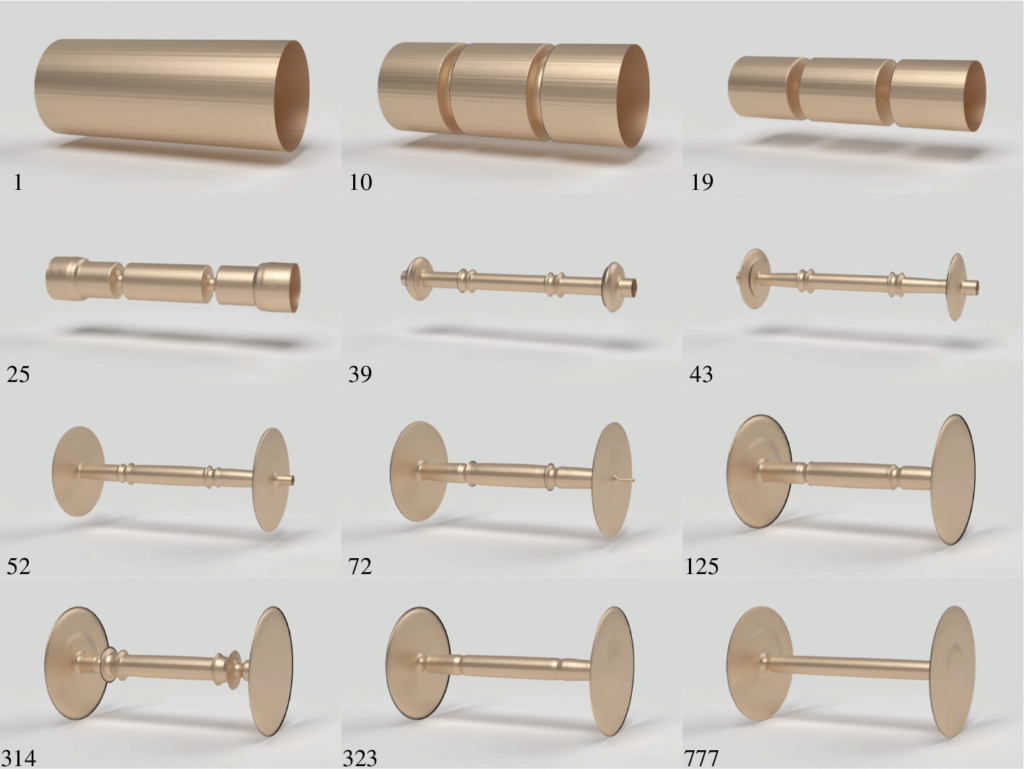Necessity may be the mother of invention, but the wheel is her most famous child. On its own the wheel is pretty useless, but the system of wheel and axle turned out a pre-historical technological revolution. But when, where, why, by whom and how often has the wheel been been invented?
After all, we can do fine without a wheel. Many, notably the Americans, never used wheels for transport. Early seafarers got around well without it too. But in Eurasia and North Africa the wheel spread early on. So early that it is hard to track its origin, design process and use-case.
There are two obvious precursors to the wheel, the sled and the roller. A sled is designed to minimise friction when dragged or pushed. A roller is a de-branched tree trunk rolling between the ground and the cargo. Rolling reduces friction even more, a process that ultimately gave us ball bearings.
This paper gives a convincing origin story for the wheel: Reconstructing the invention of the wheel using computational structural analysis and design
Abstract
The invention of the wheel is widely credited as a pivotal moment in human history, yet the details surrounding its discovery are shrouded in mystery. There remains no scholarly consensus on key questions such as where, how and by whom this technology was originally invented. In this study, we employ state-of-the-art techniques from computational structural mechanics to shed light on this long-standing puzzle.
Based on this analysis, we propose a probable path along which the wheel evolved via a sequence of three major innovations. We also introduce an original computational design algorithm that autonomously generates a wheel-and-axle system using an evolutionary process that offers insight into the way in which the first wheels likely evolved nearly 6000 years ago.Our analysis provides new supporting evidence for the recently advanced theory that the wheel was invented by Neolithic miners harvesting copper ore from the Carpathian Mountains as early as 3900 BC. Moreover, we show how the discovery of the wheel was made possible by the unique physical features of the mine environment, whose impact was analogous to the selective environmental pressures that drive biological evolution.
Lee, Bulliet, and James https://doi.org/10.1098/rsos.240373

As the argument goes there are not many use-cases where primitive wheels would have a major design advantage over the precursors, rollers and sleds. However in the narrow tunnels of pre-historic copper mines rollers wouldn’t be a convenient technology, and it would be less trouble to fix the rollers to the cart. That would turn them back into sleds with high rolling friction. However, by applying grooves, grease and continuous improvements they had a winning design.

A three-piece system of two wheels and one axle would have manufacturing and maintenance advantages over a monolithic one-piece wheelset. Or for that matter a single wheel and axle system.
As long as the wheels are fixed to the axle the vehicle cannot easily turn as the left and right wheels must move at the same speed, and in a turn the outer wheel will move faster. Only when the wheels are decoupled from the axle can they turn fairly friction-free.

Incidentally, trains reinvented the wheel in an interesting way.
Early wheelsets could reduce toil where the ground was firm, but did not increase mobility. For that to happen draught animals and mobility innovations were needed, like the hub, spoke and rim. Even later engineers adapted wheels into cogwheels.
So now we know?
This is a good story, but we don’t know if it is the story. Obviously the miners in question weren’t actually Slovaks, Slovak identity wouldn’t be invented for many more millennia. The archaeological finds in the Boleráz municipality, next to Bratislava, that gave name to this culture, or phase, didn’t mean that the wheel was necessarily invented there, or only there, or first there. Panta chorei.
Later the copper age gave way to the bronze age, with greatly increased globalisation and a trade network spanning half the globe. The wheel has turned out quite useful in hindsight, but design prototypes and false starts don’t usually show up in archaeological record.